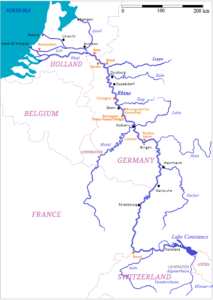World War Two
Julie’s story is set against the backdrop of war. Born just a few years after demobilisation, she enters a world dominated not only by Britain’s weakened power on the world stage, but one where individuals have suffered great personal loss. Fallout of from the Blitz, a defeated Germany, lives scarred by tragedy, and fourteen years of food rationing which finally ended in 1954, set the scene.
By the time [my parents] got married just after the second world war, they’d reached their late thirties. From years of hardship and suffering, something had been salvaged: love and gratitude. And they were thankful to have salvaged something else, the chance to raise a child from babyhood as their own. An injustice put right, so it seemed.1The Bombshell
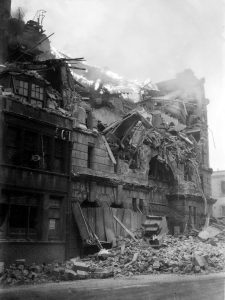
Portsmouth in the Blitz, 1940
During the war, after the failure of the Battle of Britain, Germany launched a series of devastating air raids on Britain’s towns and cities. The ‘Blitzkrieg’, meaning ‘lightning war.’
One of the chief targets was Portsmouth, on the south coast of England. It is still home to the Royal Navy and the Royal Naval Dockyard was therefore an important target. However, aerial attacks were not very accurate in those days, especially during nighttime raids. Consequently many civilian areas were hit.
The city had been prepared for the attacks, and numbers of Anderson Shelters were supplied by the government, some of which individuals had to erect themselves. Underground and brick built shelters were also constructed and employed. Despite this, the death toll was still high. Three major raids took place between August 1940 and March 1941. 930 civilians were killed in Portsmouth during the war.
‘Terrible, that bomb was,” Aunt May continued, returning to the subject while boiling the electric kettle and making tea. ‘The air raid warning had been sounded. Rachel tried to get James’s mother out of bed and down to the shelter. But there wasn’t time – suddenly the Heinkel was overheard, bomb doors opening. They took a direct hit. James’s mother was blown right out of the window – the bed landed in the street with her inside it. Rachel was found in an understairs cupboard. Dead.’10Mr. McDonald
Much of the story takes place on the south coast of England, yet also has its roots in the German Rhineland.
Impressionable memories of a Rhineland cruise were re-awakened – a vision of a swastika daubed in red paint on a wall reminding my parents of things on which, even back then, I sensed they preferred not to dwell. And recollections of things they did voice, such as the affluence of a nation that had leapt ahead of Britain, seen in the shops and streets of Cologne and Bonn. And there was the vision of the Lorelei Rock approaching on the starboard bow, shrouded in ghostly mist, invoking the legend of Wagnerian sailors lured to their deaths by a mermaid.5Digging up the Past
Beside us, the waters of the River Rhine lapped against piers and moored vessels…. We were on our way back from a visit to the Peace Museum, where we’d become engrossed in the harrowing tale of the capture and collapse of the Remagen Bridge in 1945, portrayed by pictures and artefacts, in addition to information about the local American prisoner of war camps.27If Only
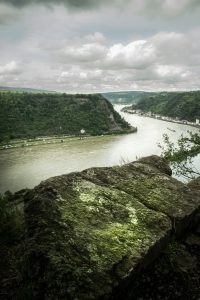
The Lorelei Rock
At the end of the war, the mighty River Rhine was the final barrier between the Allied armies and Germany’s industrial heartland: the Ruhr. On March 23rd 1945, ‘Operation Plunder’ was launched under the leadership of Field Marshall Montgomery, as part of a series of coordinated attacks on Germany involving Rhine crossings. He wrote: The Rhine is some river, but we shall get over it.
Yet it was so much more than just a river – indeed a massive waterway conveying barges from Rotterdam to Basel, as well as the wellspring of the country’s ancient myths and legends. The breaching of this powerful, hallowed waterway struck at the very heart and soul of the enemy.
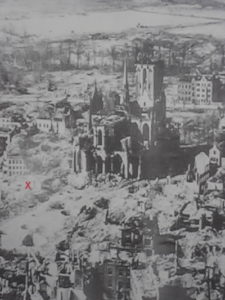
Wesel after the allied bombardment
The first crossing of the river took place at Rees, just north of Wesel, then at the mouth of the River Lippe further south, at a point where it flows into the Rhine. Thus began a huge bombardment from air and ground, destroying much of Rees and Wesel.
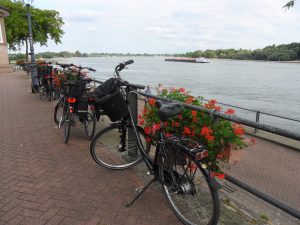
River Rhine from Rees
On March 7th another crossing took place to the south of the Ruhr, as part of Operation Lumberjack. The intention was to draw away any enemy forces in opposition to Plunder. Following the capture of the Siegfried Line, the 9th Armored Division of the US First Army unexpectedly seized the Ludendorff Bridge across the Rhine, at the Battle of Remagen, and established a bridgehead on the opposite bank at Erpel.
The railway bridge had been built during the First World War in order to transport soldiers and supplies to the Western Front. Its capture enabled the US troops to infiltrate the eastern side of the Rhine. After many attempts by the German army to destroy the bridge, it collapsed ten days later, killing 28 US engineers and injuring many more.
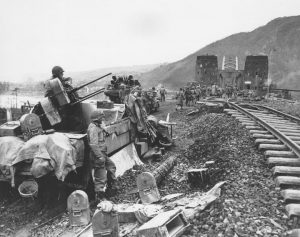
The Ludendorff Bridge after its capture
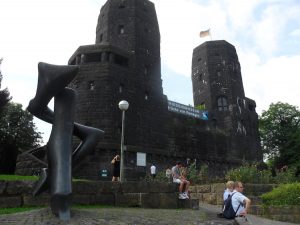
The Peace Museum at Remagen
The bridge has never been rebuilt and the remaining towers on either river bank, which were constructed to accommodate troops and were equipped with fighting loopholes, still stand. The ones on the Remagen side have been converted into the Peace Museum.
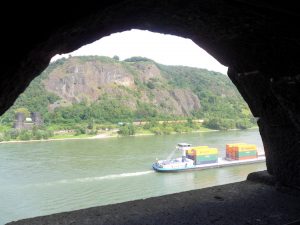
River Rhine from the Peace Museum
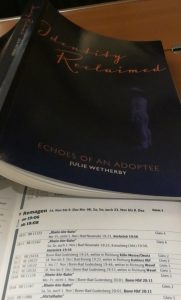
The much-travelled memoir on a German train approaching Remagen
This book really deserves to be successful with its message encouraging others to find peace with difficult things.
